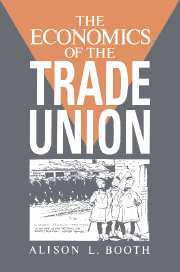Book contents
- Frontmatter
- Contents
- List of figures
- List of tables
- Preface
- 1 Introduction
- 2 The development of the union movements of Britain and the United States
- 3 The orthodox theoretical framework: an overview
- 4 Trade union objectives and the monopoly union model
- 5 Bargaining models of the trade union
- 6 Empirical estimates of the union wage differential
- 7 The impact of trade unions on productivity, investment, profitability, employment and hours
- 8 Unions and the macroeconomy
- 9 Conclusion
- References
- Index
7 - The impact of trade unions on productivity, investment, profitability, employment and hours
Published online by Cambridge University Press: 07 October 2009
- Frontmatter
- Contents
- List of figures
- List of tables
- Preface
- 1 Introduction
- 2 The development of the union movements of Britain and the United States
- 3 The orthodox theoretical framework: an overview
- 4 Trade union objectives and the monopoly union model
- 5 Bargaining models of the trade union
- 6 Empirical estimates of the union wage differential
- 7 The impact of trade unions on productivity, investment, profitability, employment and hours
- 8 Unions and the macroeconomy
- 9 Conclusion
- References
- Index
Summary
Introduction
The orthodox view of monopoly trade unions is that they achieve a monopoly wage gain at the expense of one or more parties: nonunion workers who may receive lower wages; consumers if the cost increases can be passed on in the form of higher prices; or capitalists whose profits may be reduced. We saw in chapter 3 that a necessary condition for wage gains is the existence of economic rents in the product market. It was also argued that in order for a union to achieve wage gains, it must have the necessary power to force the firm to share the surplus. Alternatively, the firm must be willing to share any surplus with the union in exchange for higher productivity.
The latter view – that unions may be associated with productivity increases – is the focus of the first part of this chapter. While the monopoly ‘face’ of trade unions focuses on the negative aspects of unionism, an alternative view of unions is that in some circumstances they may be efficiency-enhancing, in the sense that the presence of a union may result in improvements in the organisation of the workplace and the productivity of the workforce. How does this improved productivity come about? There are two popular views in the literature, both of which can be placed under the broad heading of organisation theories, since unionisation may affect organisation of production and workers' incentives.
- Type
- Chapter
- Information
- The Economics of the Trade Union , pp. 183 - 223Publisher: Cambridge University PressPrint publication year: 1994



